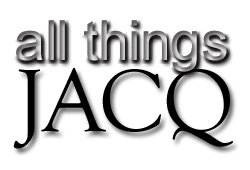| Jacqueline: | Our apologies. It's been nearly six months since our last snarky graphic adventure review. Our thanks to Gunther Schmidl for sending us some games that he'd like to see torn limb from limb. Maga, do we have the sangria ready?
|
| Sam: | Ready? I'm approaching the bottom of the second pint. I've got to occupy myself somehow while you do all that formatting.
|
| Jacqueline: | Well, if you're properly sauced up, let's begin! |
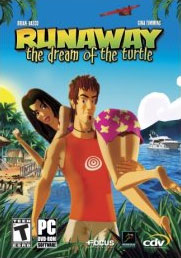
|
| Sam: | Runaway 2: Dream of the Turtle is a graphic adventure sequel whose title bears little or no relevance to actual game content. (Also, the over-shoulder chick on the box cover? She only appears in the initial cutscene.) We haven't played the first game in the series, Runaway: A Road Adventure, but we scoff at such minor impediments.
|
| Jacqueline: | Not to give away too much too fast, but I think that after playing Runaway 2, I might actually be willing to play its prequel.
If someone bought it for me.
|
| Sam: | I've seen stronger recommendations.
|
| Jacqueline: | Well, I almost said 'if someone paid me.' But I think if they bought it for me, that'd be good enough. Probably.
|
| Sam: | The hero of Runaway 2 is Brian Basco. Apparently in the first game he was something of a shirt-and-tie geek, but by this game he has metamorphosed into some sort of jock/surf dude/metrosexual. He undergoes many makeovers in the course of the game, but never loses his soul-patch.
|
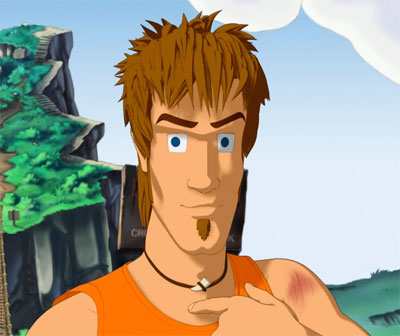 Brian Basco: soul-patched mouth-breather.
Brian Basco: soul-patched mouth-breather.
|
| Jacqueline: | I wanted to like him. Really I did. For once, we were playing a game with a pseudo-attractive male PC. I mean, let's take a look at a shot from the (agonizingly long) opening cut-scene movie:
|
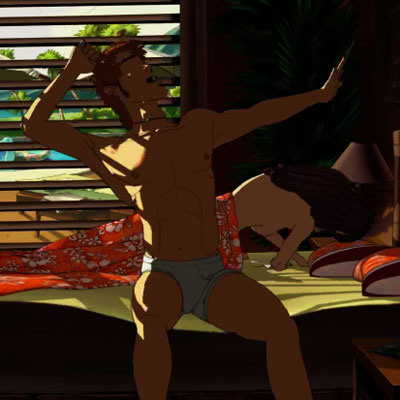 Bam! Grass don't grow on a playground!
Bam! Grass don't grow on a playground!
|
| Jacqueline: | My first reaction to that was, "For once we play a game with a hott male protagonist! Hooray!"
But then I realized that he would only actually be hott if he could keep his mouth shut. The more he talked, the more I disliked him. There were classic moments, like right after the game begins and we find ourselves alone in a wrecked plane in a jungle in the middle of absolute nowhere and, in searching through the plane, we find some maps! Hooray! Brian's response? "Nah, I don't think it would do me any good." Speaking as a pilot, I can comment with some authority on the game's authenticity here: <sarcasm>all you need in your survival gear on a plane is anti-slippage spray, a jug of water, and some sort of wrench/crank thing to use as a weapon against lemurs. And maps? Overkill, really.</sarcasm>
|
| Sam: | Apart from the soul-patch, Brian is a semi-effective smartass, a giant wuss in the truest Kate Walker dirty-wet-stick tradition, a horrific liar, and just camp enough to be annoying without going the whole hog and being properly camp. Worst of all, however, is his habit of constantly explaining why he's going to do something, at length and out loud, before he actually does it. I mean, okay, it's nice for the player to have some idea of PC motivation, and I guess it helps with puzzle direction -
|
| Jacqueline: | Wait. Helps with puzzle direction? Let's face it, some of the puzzles were so unintuitive that we started combining random objects in our inventory and if Brian hadn't been there to explain precisely what his wack thought process was, we never would have known... but I guess we'll rip more on the puzzles later.
Back to the topic at hand, Brian had his moments. Why, I think even you and I had a little bit to learn from the worldly adventuring chap, didn't we, Sam?
|
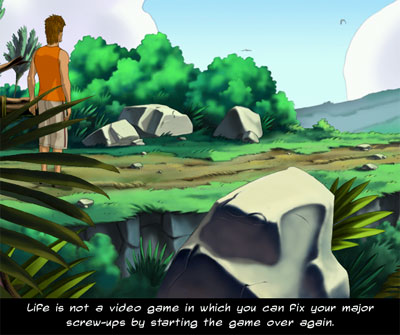
|
| Sam: | Except that, y'know, it's more or less impossible to make the game unwinnable, so you mostly save in order to avoid the cutscenes and the occasional bug (we encountered only two, but one of them was a show-stopper).
Brian is supported by a frankly immense cast of NPCs, all rendered in a fluid, naturalistic style that nonetheless retains a strong cartoony element.
|
| Jacqueline: | Yes, I was very impressed with the animation during the opening scene. That's not atypical for graphic adventure games, but I figured that the graphics would degrade once we left the carefully-animated movie and hit the actual game play. On the contrary, the graphics continued to be excellent, with nice camera angles.
|
 Natural animation, interesting angles, general prettiness.
Here, an overhead view of the cockpit in the wrecked plane.
Natural animation, interesting angles, general prettiness.
Here, an overhead view of the cockpit in the wrecked plane.
|
| Jacqueline: | Overall, the game uses an animated style vaguely reminiscent of Dragon's Lair. I guess it's about time... Dragon's Lair was, what? Twenty-four years ago... it's about time designers and personal computers caught up. (Granted, I've probably missed other games with well-executed animated graphics for PCs. Whatever.)
|
| Sam: | Most of the NPCs, to be honest, are one-gag wonders, but they're fairly well-rounded for one-gag wonders. Nobody gets any character development whatsoever, but at least the caricatures are nicely filled out. If that makes any sense.
|
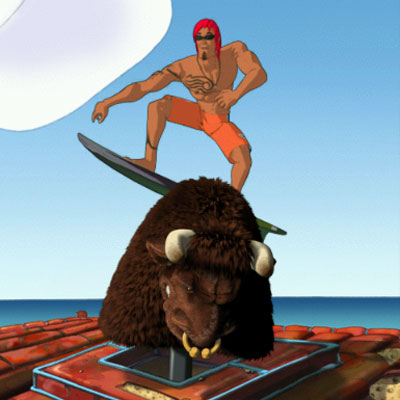 Knife, the Aussie surfer, exists solely to
showcase the fluid character animation.
Knife, the Aussie surfer, exists solely to
showcase the fluid character animation.
|
| Jacqueline: | Okay, this review is starting to be almost as random as the silly game. Let's start structuring this.
Hm... let's see...
Okay, plot. Brian and his girlfriend, Gina, are on vacation in Hawaii, when they accidentally cross paths with the wrong end of the United States government, which happens to be guarding a UFO that crashed in a lake on a made-up island. (Yes, we warned you the review was somewhat spoilery. Get over it.)
|
| Sam: | (Along the way it does a fairly nice job of taking the piss out of the US military. Not in a particularly insightful, subtle or constructive manner, you understand, but I approve nonetheless.)
|
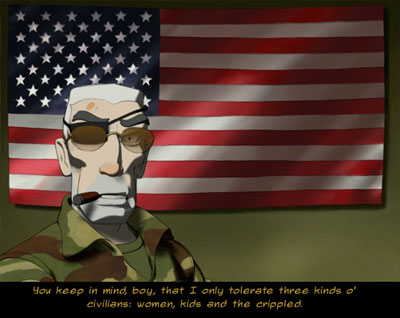
|
| Sam: | The plot ricochets randomly around between a jungle aeroplane crash site, a beach resort, an ancient temple, the Alaskan interior, a ship in the middle of Some Ocean, and, um, a pirate ship in The Past.
|
| Jacqueline: | A brief aside - I'm proud to report that, despite a portion of the game being set in Alaska (more analysis of that later, kids) there were no arctic penguins in this game.
There was, however, a recurring Hawaiian lemur.
|
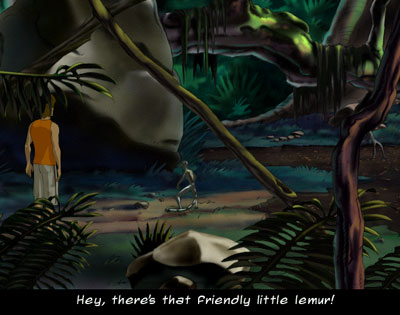
|
| Sam: | Lemurs? Hawaii?
|
| Jacqueline: | They're only found on the one Hawaiian island, called Madagascar Mala. Don't you know anything? I learn all my geography from videogames. Follow my lead, babe. You'll go places. (Actually, during a conversation with one of the Mala natives, the game designers carefully included a brief bit of backstory about how exotic lemurs were accidentally introduced to the island.)
|
| Sam: | Anyway... If those locations don't sound like particularly logical bedpartners, they're not; it requires an immense amount of tedious expository cut-scene to link them up. Usually, the cut-scenes don't involve much except for the characters talking. Or, even more excitingly, instant-messenger chatting.
|
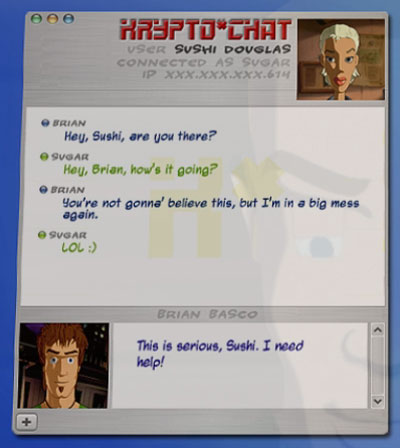 omg this scene was deemed so enthralling
that it became the main frame-story :(
omg this scene was deemed so enthralling
that it became the main frame-story :(
|
| Jacqueline: | rofnlbbiip
|
| Sam: | wtf?
|
| Jacqueline: | Rolling on floor not laughing but because I'm in pain. Didn't you ever go to actual chat rooms? Everyone knows that.
|
| Sam: | Well, mrf. Many things - the poppy soundtrack, the abundant T&A, the scatological humour, the yet another frickin' comedy Rasta - suggest that Runaway 2 is aimed at getting a younger, semi-geeky audience interested in graphic adventures, rather than the core late-20s/30s seriously-geeky audience.
|
| Jacqueline: | Abundant T&A? Sophomoric low-brow humor? Innuendo? Oh, you mean the the standard level of humor which included scenes like this:
|
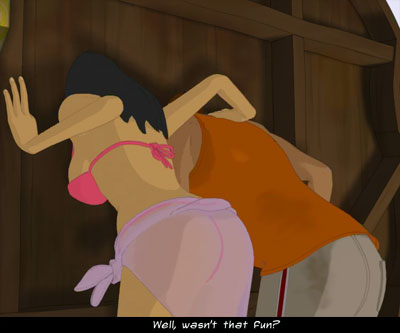
|
| Sam: | Ah yes, Lokelani. This is another thing about the game: it piles on the pop-culture references like nobody's business. These include plenty of graphic adventure references (lots of nods to Monkey Island, and Brian frequently breaks the fourth wall, usually with regard to his bottomless booty pockets) but the Lokelani sequence is a pretty straightforward rip on Japanese-derivative dating sims. Except in this case, the inane list of questions that have to be remembered from previous conversation in order to get into her pants? All about her ex-boyfriends. I'm not sure if this is intended as parody, or if it's just straight lifting which accidentally sort of looks like parody.
|
| Jacqueline: | Oh, come now. The boyfriend puzzle works because Lokelani has taken the time to tell us a bit about herself, to give her character some dimension. And some of those conversations were very down-to-earth. Very real life. Take, for example:
|
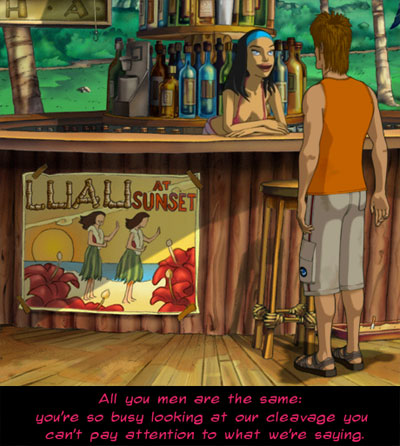
|
| Sam: | *dons banana hammock* Damn it, why can't you ladies stop looking at my junk? You're so immature.
|
| Jacqueline: | Wha?
|
| Sam: | Do I have to explain to you what a banana hammock is?
|
| Jacqueline: | Snrk. No... keep talking while I try to stop laughing.
|
| Sam: | Okay. Back on track. Um. So, how about those pretty settings? They're well-integrated with game content and you hardly ever have to go hotspot-hunting in them...
|
| Jacqueline: | You pretty much never have to go hot-spot hunting in them. Most of the backgrounds are just that - backgrounds. However, on half a dozen or so occasions, the designers came up with something that's truly beautiful. Not exactly Myst-level, but as beautiful as it can be and still have it work with the animation found throughout the game.
|
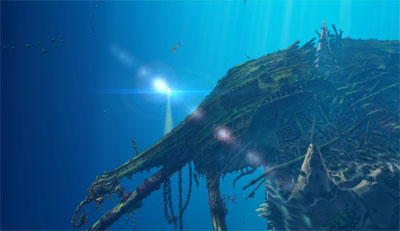 A sunken pirate ship. Oooh. Shiny.
A sunken pirate ship. Oooh. Shiny.
|
| Jacqueline: | Unfortunately, the designers realized when they were doing this. Sometimes you were forced to endure the prettiness during a very long movie, sometimes you merely had to visit the locations time and time again as you tried to solve a particular puzzle.
Which brings up a spectacularly annoying bit: the whole YOU MUST FAIL BEFORE YOU CAN SUCCEED method of puzzle-solving in this game. |
| Sam: | Puzzles. Oh me oh my. This was one of the more variable parts of the game. At times, puzzles would be intuitive, well-clued, logical, have credible explanations for disallowed solutions, automatically perform obvious sub-steps, and clue in subsequent puzzles. At other times, they were unintuitive, arbitrary, convoluted, unclued, tortuous, and/or flat-out stupid. On several occasions we worked out the puzzle but couldn't carry it out because Brian hadn't cottoned on yet.
Generally speaking, puzzles were structured in a fairly linear way (I should probably despair of ever seeing a genuinely multilinear graphic adventure again) but abundant in-game pointers generally enabled you to piece together the general order of puzzle-solution in any given segment. Nonetheless, we used hints a great deal. About half the time we would respond with 'oh, hunh, that was pretty well-clued, why didn't we try that?' The other half, we would howl in agony at the horrific idiocy.
|
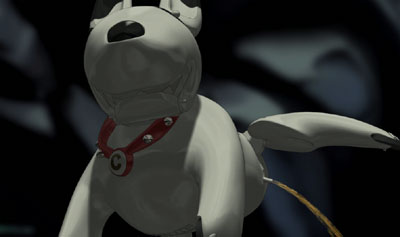 High-class puzzles
High-class puzzles
|
| Jacqueline: | There were many moments where we damn well knew the solution, but unless Brian first tried something that was almost right, so that he (and we) could learn from his failure, we weren't allowed to solve the puzzle in what would ultimately prove to be the correct way.
There were also a lot of conversation puzzles. We learned early on that you should exhaust every available conversation menu option, no matter how random or tangential you thought the conversation thread might prove to be - |
| Sam: | - and then later on you should return to that character and exhaust them all again.
|
| Jacqueline: | Yes. Just in case. Half the time I sat there clicking through dialogue wondering why the designers hadn't just made most of the conversations into longish cut-scenes, seeing as how they're so fond of those.
|
| Sam: | The thing was, the game was essentially designed by a bunch of guys who got really excited during the brainstorming phase and sketched out an inordinate number of totally unrelated characters and locations that they thought would be cool; and then Erich von Daniken wandered in, handed everyone a spliff, and suggested that hey, if you put some aliens in maybe it'd work.
There's a big chunk where they obviously intended to put in a chapter set in Palenque (That Place In South America Where They Found the Bas-Relief where the Dude Totally Looks like he's Piloting a Spaceship) but they ran out of space and had to summarise that chunk of the plot in another cutscene. Whereas they did feel the need to explain why the McGuffin is in a slightly different location than expected with an entire chapter, in which we go back to the Age of Pirates for no reason than the aforementioned brainstorming clusterfuck and the fact that People Like Pirates. (Brian gets a dreadful accent that isn't sure if it's Irish or English or his normal voice.) And then there's a half-assed historical-characters-are-analogous-to-modern-characters thing. Clusterfuck.
|
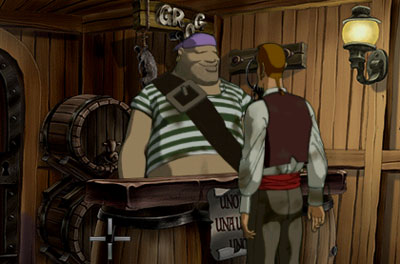 Pirates! Because pirates are cool!
What do you mean we need a reason?
We're talking about pirates!
Pirates! Because pirates are cool!
What do you mean we need a reason?
We're talking about pirates!
|
| Jacqueline: | We've been tearing this game a new one for a few minutes, and it seems like it's about time we said something nice...
Let me just look through my game notes here...
Lessee...
Oh! Interface. Yeah, the interface was pretty good, actually. Intuitive, and in addition to getting captions for the dialogue, we also got captions to show how the game was interpreting our cursor actions. This proved very useful for figuring out how to manipulate objects and find your way around, and the authors also used it, from time to time, to make us laugh:
|
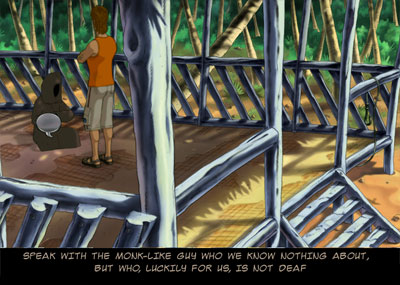 Just in case there was any ambiguity.
Just in case there was any ambiguity.
|
| Sam: | Again, the humour was hit-and-miss. Sometimes it was juvenile or cheap, sometimes it relied on Brian's semi-camp smartassery and fell flat, but occasionally it hit it on the head. Sample exchange with Rutger, the comedy Rasta: Brian: Can you explain the Rastafarian religion?
Rutger (irate): No. The action-caption jokes constitute a rather large chunk of the actually-funny gags.
|
| Jacqueline: | This seems like a good time, more or less, to include this screenshot:
|
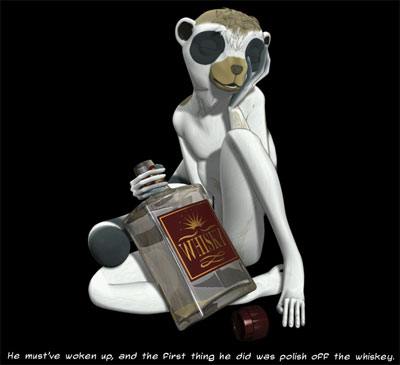
|
| Jacqueline: | Sorry. I just had to find a spot for a drunken lemur during the review, and that seemed like the most appropriate place.
So, let's see. Thus far we've established:| Good | Bad | | Great graphics | We hate Brian | | Intuitive puzzles | Unintuitive puzzles | | Moments of laughter | Moments of agony | | You can't make
the game unwinnable | You can't make
the game unwinnable | | No arctic penguins | Hawaiian lemurs |
Speaking of arctic penguins, we can't finish this review without discussing, in a touch more detail, how they portrayed Alaska. Seeing as how we live in Alaska, and everyone loves to make kerrazy stereotypes about a place they've probably never visited. The verdict? I think at least one member of their staff had, at some point, actually visited Alaska. Or, at a minimum, the design team rented a lot of episodes of Northern Exposure while working on the game. I suspect the latter, because they make reference to the nearby town of Cicely, AK.
A lot of the scenery was pretty accurate, though I don't think I've ever seen trees quite that big near Fairbanks. The characters during the Alaskan section were stereotypically quirky, but then, everyone in this game is pretty quirky. I must say that their excuse for coming to Alaska, to find the whereabouts of a notable and civilized academic who has sequestered himself from society by living in the wilderness, is not at all off of the mark, as I personally know at least one of those doing just that here in the state.
But anyway, rather than go on at length about a bunch of stuff most of you lower-48ers could care less about, we'll hit the high point and the low point:
|
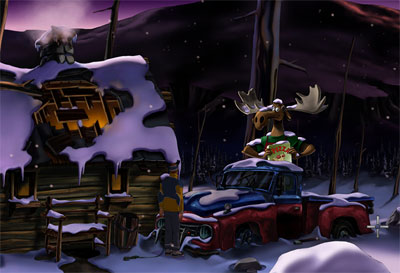 HIGH POINT
HIGH POINT
|
| Sam: | If you're confused as to why there's a moose with a pizza box, it's a reference to Bullwinkle's, the Juneau pizza joint (also known as The Magical Land of Pizzas) that themes itself after the cartoon. It's a decent pizza joint, but it's not exceptional; it's just one of the quirkier things about Juneau. If this was intended as a bribe to Alaskans (to make them forgive any errors), it worked, because we both essentially went 'OMFG MAGICAL LAND OF PIZZAS'.
|
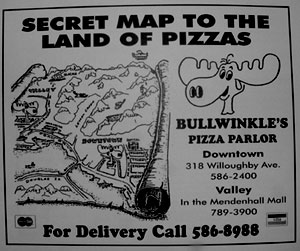
|
| Jacqueline: | Maga and I have gone 'round and 'round on whether nor not this was an intentional reference. He thinks it's "almost certainly" intentional, while I have my doubts and think it entirely possibly that it's just a crazy coincidence.
|
| Sam: | But he called it Bullwinkle!
|
| Jacqueline: | If you grow up in the US or Canada watching The Rocky and Bullwinkle Show, you probably call every moose "Bullwinkle."
|
| Sam: | But!
|
| Jacqueline: | But anyway... on to the low point: the way the game deals with bear-human interaction.
|
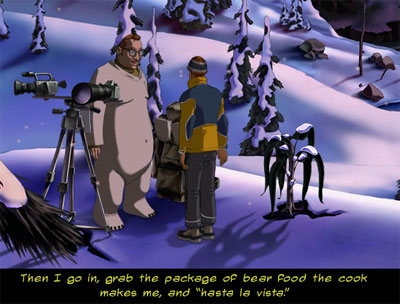 LOW POINT, EXHIBIT A
LOW POINT, EXHIBIT A
|
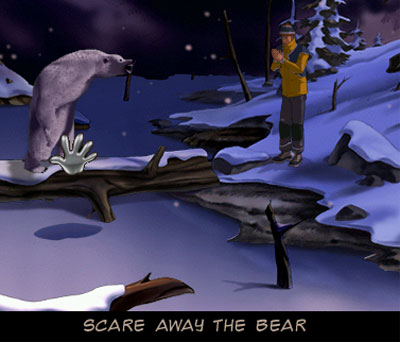 LOW POINT, EXHIBIT B
LOW POINT, EXHIBIT B
|
| Jacqueline: | That's right. The park ranger does not approve of feeding or harassing wildlife. Nor is it recommended that you feed or harass polar bears. Nay, this is quite possibly the worst species to even consider harassing, scaring, feeding, etc. And I won't even comment on the fact that it's rather unlikely to find polar bears roaming as far south as the Fairbanks region.
Don't worry, though. In the end, Brian does not actually harass, scare, or feed the bear. Nor, unfortunately, is Brian mauled (oh well), but the creepy furry in Exhibit A gets what's coming to him (yay).
|
| Sam: | Brian's about six feet from the bear. Polar bears are not like other bears: they see humans as frickin' prey. He needs to be mauled so that he can't bang any more hot chicks and spread his stupid genes around.
|
| Jacqueline: | Sadly, realism was not a common theme in this game, Sam.
I think that pretty much covers the game. If you like quirky graphic adventure and come across a copy in the discount bin, it's recommended. If you adore quirky graphic adventure and thrive on adolescent humor, go find a copy on eBay right this second. If you have more money than sense, go buy it new on Amazon for $27.99. |
| Sam: | Once again, thanks, Gunther.
|
| Jacqueline: | Yes, thank you...
|
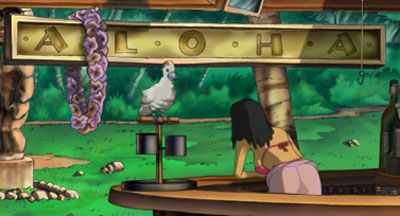 ...and aLOha!
...and aLOha!
|
